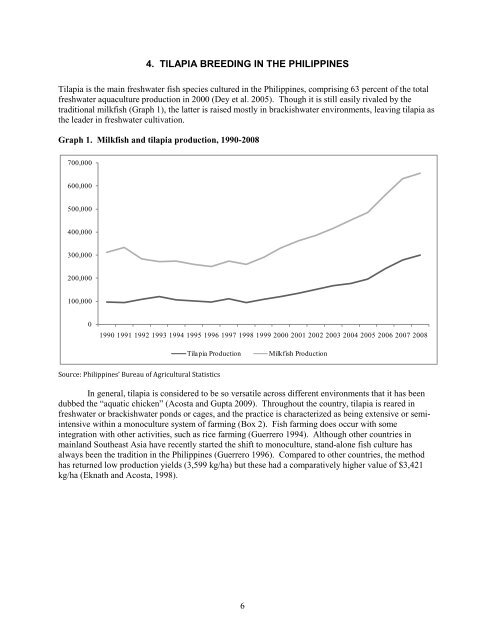Rich Food for Poor People - International Food Policy Research ...
Rich Food for Poor People - International Food Policy Research ...
Rich Food for Poor People - International Food Policy Research ...
Create successful ePaper yourself
Turn your PDF publications into a flip-book with our unique Google optimized e-Paper software.
4. TILAPIA BREEDING IN THE PHILIPPINES<br />
Tilapia is the main freshwater fish species cultured in the Philippines, comprising 63 percent of the total<br />
freshwater aquaculture production in 2000 (Dey et al. 2005). Though it is still easily rivaled by the<br />
traditional milkfish (Graph 1), the latter is raised mostly in brackishwater environments, leaving tilapia as<br />
the leader in freshwater cultivation.<br />
Graph 1. Milkfish and tilapia production, 1990-2008<br />
700,000<br />
600,000<br />
500,000<br />
400,000<br />
300,000<br />
200,000<br />
100,000<br />
0<br />
1990 1991 1992 1993 1994 1995 1996 1997 1998 1999 2000 2001 2002 2003 2004 2005 2006 2007 2008<br />
Source: Philippines’ Bureau of Agricultural Statistics<br />
Tilapia Production Milkfish Production<br />
In general, tilapia is considered to be so versatile across different environments that it has been<br />
dubbed the “aquatic chicken” (Acosta and Gupta 2009). Throughout the country, tilapia is reared in<br />
freshwater or brackishwater ponds or cages, and the practice is characterized as being extensive or semiintensive<br />
within a monoculture system of farming (Box 2). Fish farming does occur with some<br />
integration with other activities, such as rice farming (Guerrero 1994). Although other countries in<br />
mainland Southeast Asia have recently started the shift to monoculture, stand-alone fish culture has<br />
always been the tradition in the Philippines (Guerrero 1996). Compared to other countries, the method<br />
has returned low production yields (3,599 kg/ha) but these had a comparatively higher value of $3,421<br />
kg/ha (Eknath and Acosta, 1998).<br />
6

















